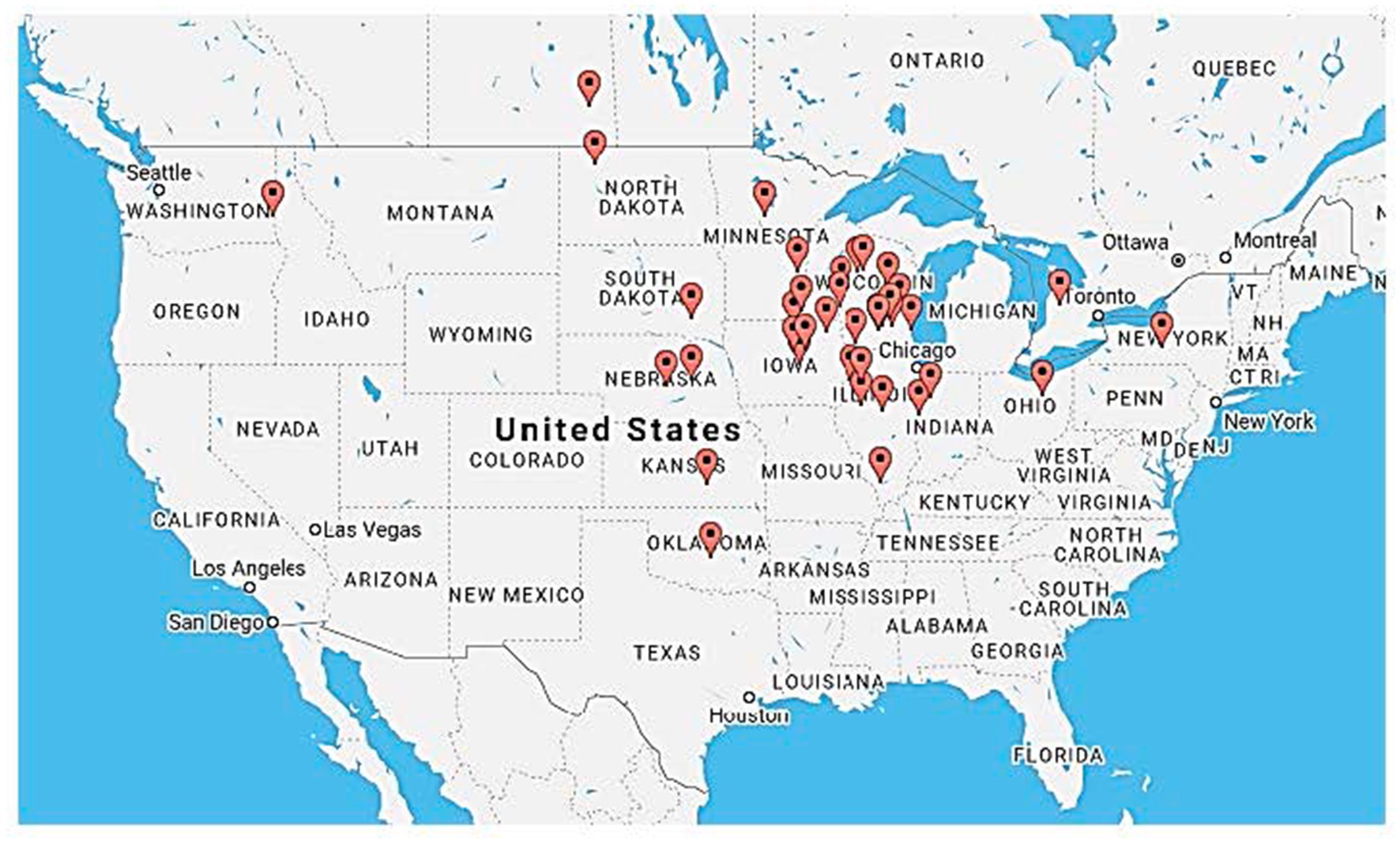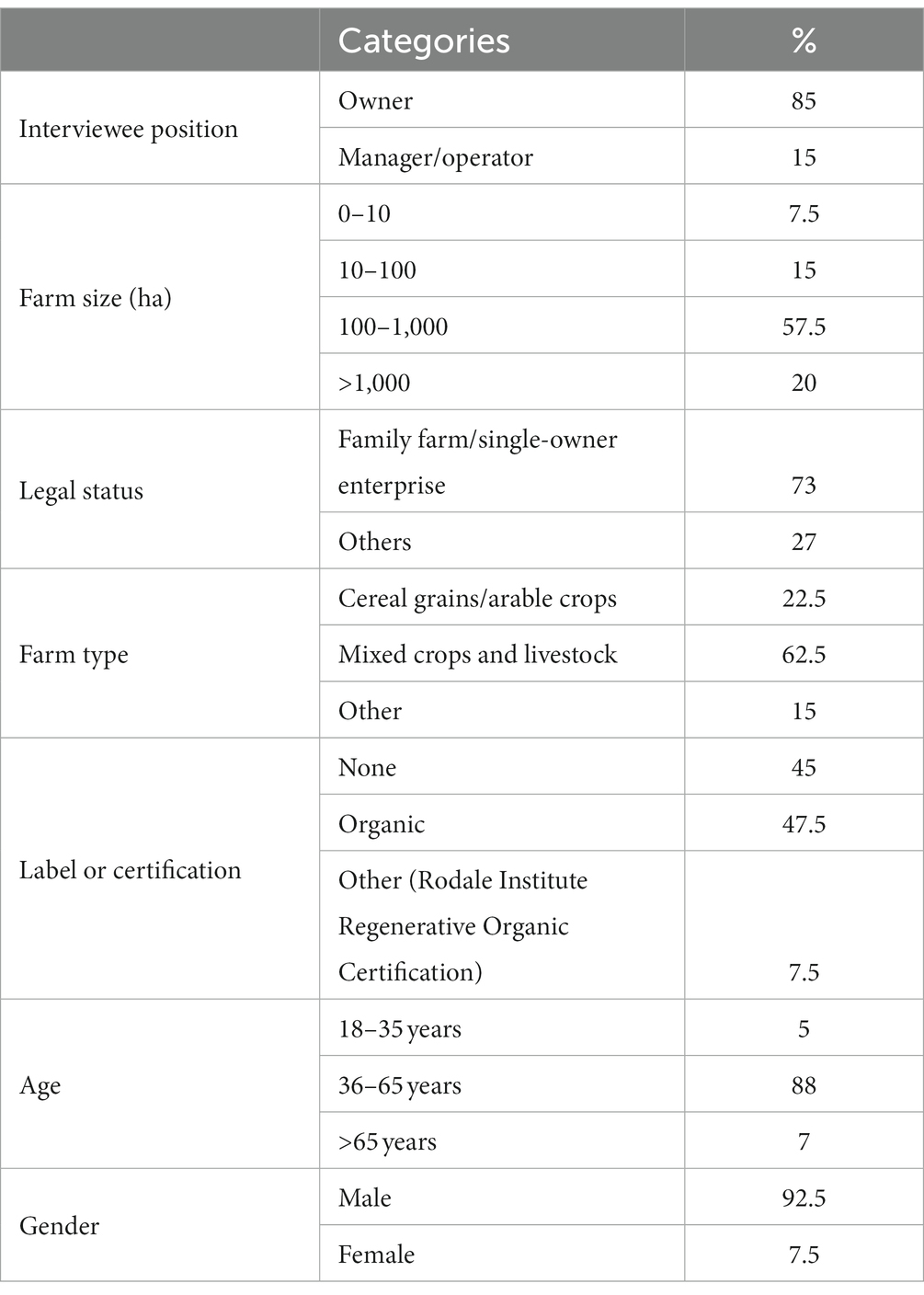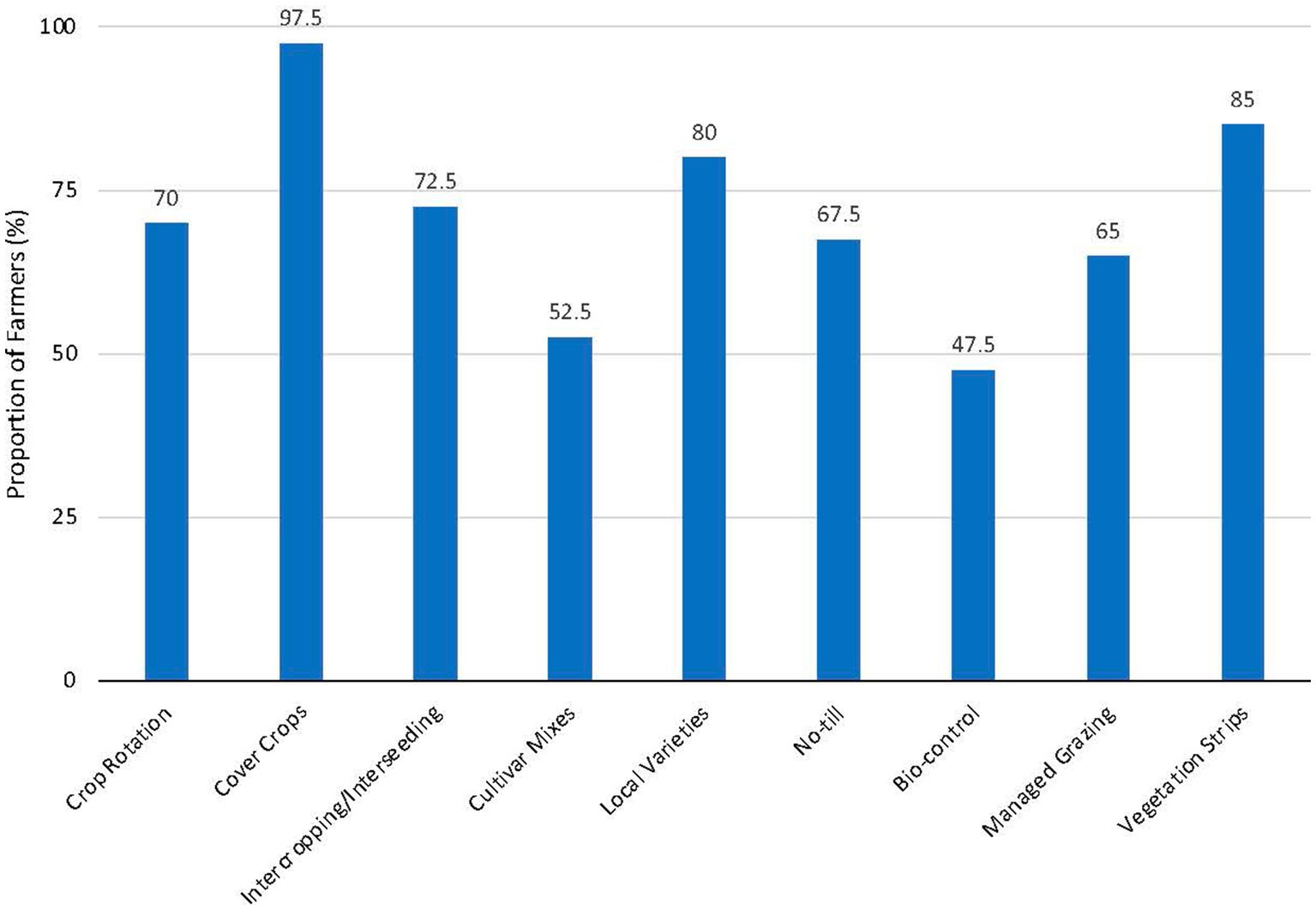- 1Department of Plant Pathology, University of Wisconsin-Madison, Madison, WI, United States
- 2Agroecology and Environment Research Unit, ISARA, Lyon, France
Introduction: The transformation of our food system towards a more resilient agroecological framework is one of the most pressing needs faced by our global community. Understanding the use of multiple conservation practices is important in the development of research, education, and policy to accelerate their more widespread integration of into farming systems.
Methods: The aim of this study was to conduct a preliminary investigation of the trends regarding multiple practice adoption of conservation farming practices by conventional and organic farmers engaging with sustainable farming methods. Forty farmers were interviewed regarding their use of conservation practices, as well as their motivations, barriers, and future plans for new implementation and expansion of current practices.
Results: Farmers spontaneously identified cover crops and vegetation strips as the most frequently used conservation practices; however, upon more specific inquiry, we found that more than 50% of farmers used additional agroecological conservation practices including local crop varieties, intercropping, managed grazing, crop rotations, and no-till, with many farmers using multiple practices. Overall, we found no correlation of organic certification with the number of conservation practices implemented by farmers. The major motivations towards the adoption of practices included improved soil quality and profitability. Main identified barriers included financial means and risk, lack of knowledge, and access to resources. Farmers showed interest in further implementation of additional conservation practices, including expanded use of cover crops, tree plantings, and no-till practices.
Discussion: Further understanding complementarities, as well as differences in barriers and motivations, can contribute to the design of effective education strategies and financial incentives to promote the simultaneous implementation of agroecological conservation practices.
1. Introduction
The transformation of our food system into a more resilient agroecological framework is one of the most pressing needs faced by our global community. As climate extremes and unpredictability continue to become more frequent and widespread, the persistent challenges of soil and biodiversity loss which result from our current agricultural production practices will only become more pronounced (Jat et al., 2014; Findlater et al., 2019). Alternative practices are being sought that can alleviate agroecosystem vulnerabilities such as soil erosion, soil and water quality degradation, excess or insufficient water quantity, degraded plant condition, soil carbon loss, livestock production limitation, inadequate fish and wildlife habitat, inefficient energy use, and air quality impacts (USDA Natural Resources Conservation Service – USDA NRCS, 2013).
Certain agricultural practices have been identified that promote the resilience of our cropping systems while enhancing environmental and societal outcomes. Many of these practices have been described using different terminology, such as agroecological practices, environmentally friendly practices, conservation agriculture, and more recently, regenerative agriculture. In particular, the term agroecological practices is increasingly used throughout the globe (Wezel et al., 2014; Wezel and Silva, 2017; Paracchini et al., 2020). However, in the United States, the most codified of these definitions is the term “conservation practices,” where individual practices may have direct associations to incentive programs administered by USDA NRCS (2013). Typical conservation practices promoted by NRCS programs include no-till, reduced-till, cover crops, contour buffer strips, water retention structures, perennial plantings, nutrient management, terraces, waterways, filter strips, prairie establishment, wetland restoration, timber stand improvement, grade stabilization, feedlot runoff control, tree plantings, prescribed grazing, and bioreactors (Kuhn, 2018).
While incentive programs exist to promote the further implementation of conservation practices, adoption is still relatively limited in the United States. For example, cover crop acres included only 3.9% of all US cropland in 2017, with the highest adoption (29% of acres) in the mid-Atlantic states and lower adoption (1% of acres) in more arid states (Zulauf and Brown, 2019). No-till management, while more widely adopted than cover crops, is also implemented on only a minority of acres, with 26% of total cropland managed with these practices in 2017 (Sawadgo and Pastina, 2022).
In the context of agroecology, within which the recognition of the need to transform practices using a systems-based context rather than the more simplistic approach of assessing the value of a practice in isolation, there is a particular importance to understanding how farmers proceed with the sequential or simultaneous adoption of multiple conservation practices to maximize agroecosystem benefits. Multiple practices integrated in tandem can create synergies which enhance and improve the effectiveness ecosystem provisioning (Hatt et al., 2018; Debray et al., 2019; Boeraeve et al., 2020; Bezner Kerr et al., 2021). Not only can the implementation of different conservation practices promote the achievement of independent goals (e.g., reducing erosion, enhancing biodiversity, and improving water quality), but the resulting effects of coordinated practices can have synergistic effects beyond those of a single practice in isolation (Christianson et al., 2018).
Several previous studies have examined rates and motivations related to farmer adoption of individual conservation practices, such as cover crops (Moore et al., 2016; Lee and McCann, 2019); no-till management (Krause, 2017; Wade and Classen, 2017); or management-intensive grazing (Foltz and Lang, 2005; Wang et al., 2020; Winsten et al., 2020). Fewer studies have examined the joint or combined implementation of conservation practices (Canales et al., 2020; Gong et al., 2021). Liebert et al. (2022) documented common agroecological practices implemented by organic fruit and vegetable farms. Focused on eight agroecological practices (intercropping, use of compost, insectary planting, reduced tillage, cover cropping, crop rotation, riparian buffers, and border planting), the authors found that farmers who managed fewer acres were more likely to use multiple practices as compared with larger farm sizes. However, the probability of adoption of any specific practice varied depending on farm size, with larger farms more likely to adopt reduced tillage practices, and smaller farms were more likely to use intercropping, insectary planting, and border planting (results based on tendencies and not statistical significant differences). While these previous studies provide insights as to the characteristics of farms adopting specific conservation practices, knowledge gaps remain about motivation to adopt or not multiple conservation practices, but also challenges and barriers farmers identify or face for adopting such practices, particularly as these trends relate to farms that have already begun to explore the integration of these practices into their farming operations.
The aim of this study was to conduct a preliminary investigation using an exploratory interview dataset of farmers choices, preferences and combinations regarding the use of multiple agroecological conservation farming practices by farmers in the USA already utilizing some conservation practices, with some complementary data from Canada. Moreover, we investigate (i) if adoption of these practices might be influenced by financial support, being under organic certification, (ii) which are the drivers for farmers’ motivation influencing the implementation of conservation practices as well as (iii) the barriers identified by farmers for adoption of practices. We specifically chose to focus on farmers with the US who already had a demonstrated level of commitment to an openness to using conservation practices as defined by the USDA NRCS, which allowed us to more deeply explore barriers, challenges, and motivations to multi-practice implementation that would lead for a more systems-based agroecological approach to conservation practice adoption. We documented the most frequently used practices by both organic and conventional farmers currently engaged with conservation cropping systems, as well as motivations, barriers, and goals for current and future implementation of practices. We chose to focus on farmers that had demonstrated a level of commitment to sustainability goals for their farms, thus enhancing our ability to begin to discern trends in the more complex implementation of multiple practices in tandem or in sequence. While this study is exploratory in nature, it provides new insights that can guide more comprehensive studies to understand the multiple underlying internal and external factors (e.g., pedo-climatic context, technical or financial barriers, farmers’ knowledge, knowledge exchange, training, policies), and farmers’ motivations leading to complementary and antagonistic practice adoption.
2. Methods
2.1. Sampling and data collection
This research employed a qualitative approach to understanding farmers’ motivations for adopting conservation practices, as well as challenges and barriers to further implementation. A qualitative approach was chosen to develop a more nuanced understanding of the types of practices farmers were using and their experiences. The conservation practices chosen to highlight within the interviews were primarily those addressed with USDA Natural Resource Conservation Service (USDA NRCS) conservation programs, thus were practices more widely recognized by farmers. Data was collected through semi-structured interviews with farmers. Thirty to sixty minute interviews via phone or videoconference were conducted in October and November of 2021, with the conversations recorded.
Purposive and snowball sampling techniques were used to recruit participants representing farmers who already had an initial degree of commitment to the adoption of conservation practices. Initial interview participants were recruited through midwestern farmer networks focused on promoting organic and sustainable agricultural practices (e.g., UW-Madison’s Organic Grain Resource and Information Network; Practical Farmers of Iowa; Wisconsin Department of Agriculture, Trade, and Consumer Protection-funded Farmer-led Watershed Groups). Further participants were recommended by other interviewees (Figure 1).
2.2. Data analysis
The interviews were split into five distinct sections: farm demographics; open-ended farmer-identified conservation practices; selection of conservation practices pre-determined within the interview structure; identification of practices currently use to control insect pests, diseases, and weeds; and motivation and barriers for future implementation of additional conservation practices. The nine pre-identified practices included: diversified crop rotation of four or more crops; cover crops; intercropping or interseeding (association of at least two crops grown simultaneously on the same field); cultivar mixtures; locally adapted/local crop varieties; no-till practices; biological control; vegetation strips on borders of or within the crop field; and managed grazing of livestock.
Demographic data and quantitative data were analysed with R software program using descriptive statistics and correlation analysis, and qualitative data was analysed through text coding based on common themes. The qualitative data regarding motivation and barriers for implementation were collected as text, analyzed, and then translated into quantitative data. First, the main themes of each interview were identified, and in a second step, similar themes across the different interviews were merged. In order to analyze the agricultural practices that were identified by the farmers, a key was created for uniformity of terminology to describe the practices (e.g., buffer strips and hedgerows were categorized as “vegetation strips” within the farmer identified practices).
3. Results and discussion
3.1. Demographic data
The interview pool including 40 farmers, primarily located in the upper midwestern USA. Most farmers interviewed (85%) identified themselves as the owner of the farm operation, with 15% identifying as the manager/operator (Table 1). Eighty-eight percent of the farmers were 36–65 years old, and 92.5% identified as male. Over half the farms (57.5%) ranged from 100–1,000 ha, 22.5% were smaller than 100 ha and 20% larger than 1,000 ha. Seventy-three percent of the farms described themselves as a family farm or a single-owner enterprise. The other farms belonged to multiple-owner enterprises. Most farms (62.5%) included livestock as part of their farm operation. Approximately half of the farms (47.5%) managed some or all their land as certified organic, with 7.5% certified under other labels such as the Rodale Institute Regenerative Organic Certification.
3.2. Conservation practices implementation
Farmers self-identified several conservation measures currently used on their farms (Figure 2). Cover crops (92.5%) were the most frequently mentioned practice, followed by vegetation strips (i.e., grass strips, waterways, flowering strips, and buffer strips) (65%), managed grazing (42.5%), crop rotation (40%), and no-till (40%).
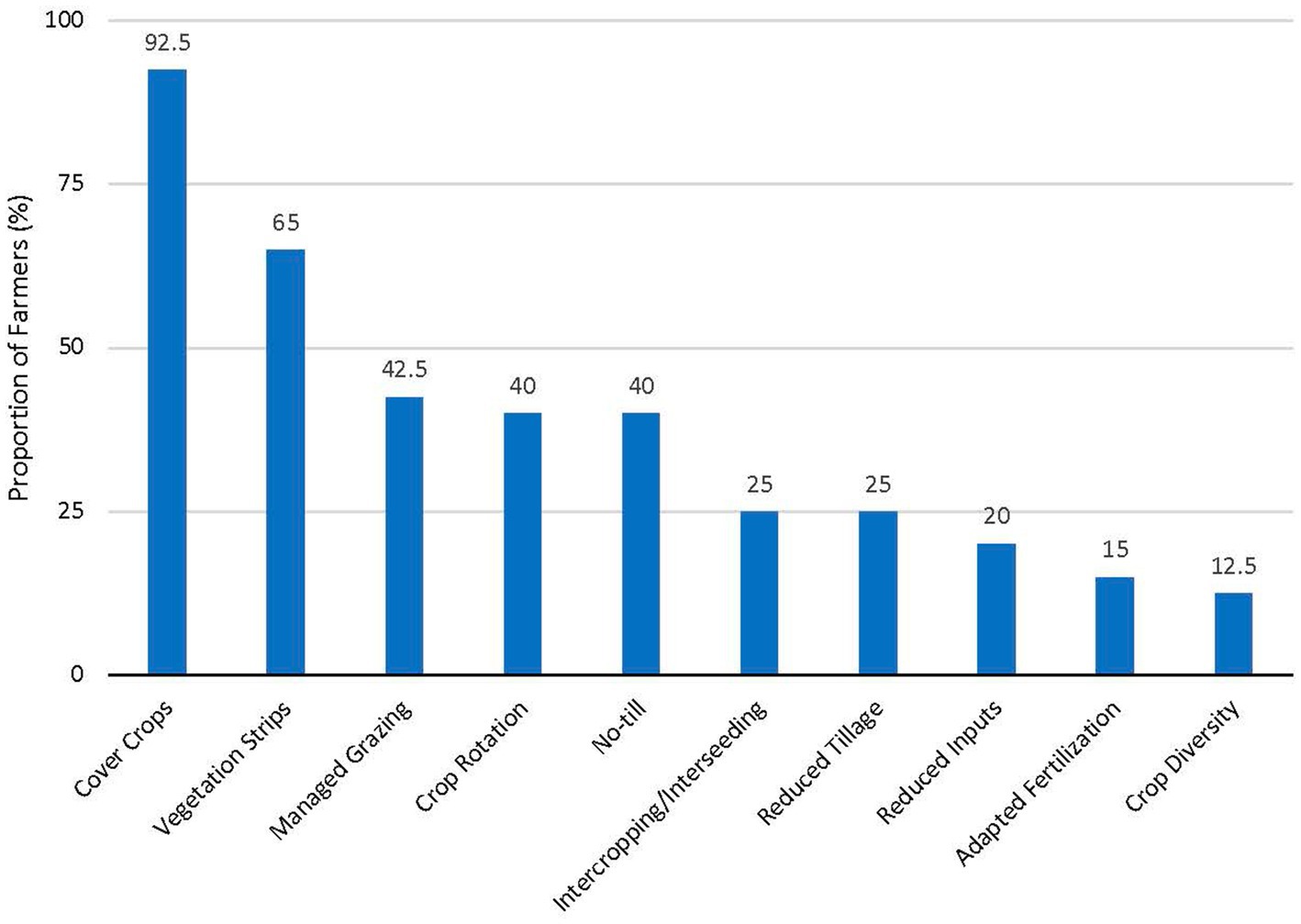
Figure 2. Agroecological conservation practices self-identified by farmers (practices are only shown if mentioned by at least 10% of farmers).
When asked about the utilization of specific conservation practices which were predefined by the interviewers, similar trends were observed as with open-ended identification (Figure 3). The most frequently implemented practices included cover crops (97.5%), grass strips (85%), and local crop varieties (80%), followed by intercropping/interseeding (72.5%), and crop rotation (70%). Managed grazing, crop rotation, and no-till were also mentioned, ranging between 65%–70% of farmers using these practices. The highest percentage of the interviewees (35%) implemented six out of ten practices, while 22.5% implemented nine out of ten practices and 17.5% implemented seven out of ten practices. Only one farmer (2.5%) implemented all ten practices presented.
The trends regarding implementation of practices employed by the farmers in our sample differed from those reported from USDA Agricultural Resource Management Survey (ARMS) (Wade et al., 2015), with the adoption of conservation practices in our study being much greater. For example, no-till practices were used by 67.5% by interviewed farmers, compared to an average of 38% across USA farms reported by ARMS. Cover crop adoption was orders of magnitude greater in our sample as compared to the national average, with almost all farmers planting cover crops, whereas previous studies have documented that less than 3% of the agricultural land within the US is managed using cover crops (Hellerstein et al., 2019). Similarly, managed grazing was implemented more frequently across our sample, with 65% of farmers using this practice compared to 22% of conventional producers in 2012 as documented in a previous study (Hellerstein et al., 2019). This greater proportion of adoption by farmers in our sample may be due to the recruitment techniques used for this study, which drew from farmer organizations with emphases on alternative agriculture approaches, including opportunities to engage with education and peer groups related to conservation practice implementation.
The use of locally adapted varieties was self-identified by very few farmers as a conservation approach (2.5%); however, when asked directly, most farmers interviewed (80%) did confirm their use of this strategy. This discrepancy in answers could indicate that farmers did not associate the use locally adapted varieties with positive conservation outcomes, despite a broader recognition of the role of targeted crop breeding and selection in the mitigation of crop nutrient needs, pests, diseases, water use, and temperature responses (Banga and Kang, 2014). Farmer definitions of “locally adapted” varied widely, perhaps exacerbating the lack of association of the practices with conservation goals. Some farmers considered cultivars as local varieties when purchased through a local seed dealer. However, other farmers identified locally adapted varieties as those that had demonstrated superior performance in their environments through yield and performance trials. A few farmers chose varieties specifically bred for their environments. Each of these approaches could have a degree of positive impact on local adaptation and associated reduction of inputs due to superior crop performance contributing to its ability to better withstand local pest and disease pressures.
3.3. Crop protection practices
Farmers associated several of their conservation practices with benefitting pest management, including the use of cover crops and crop rotation (each cited by 50% of respondents) (Figure 4). Mechanical soil disturbance (e.g., tillage and cultivation) was also cited frequently (47.5%), likely due to its common use on organic farms for weed management. Managed grazing was also identified as a tool that benefitted pest management, again likely due to its role in weed management particularly on organic farms (27.5%). Chemical protection was only identified by 20% of the interviewees as a crop protection strategy; however, alternative forms of spraying (e.g., “natural”/“non-synthetic” spraying) were utilized for crop protection as well.
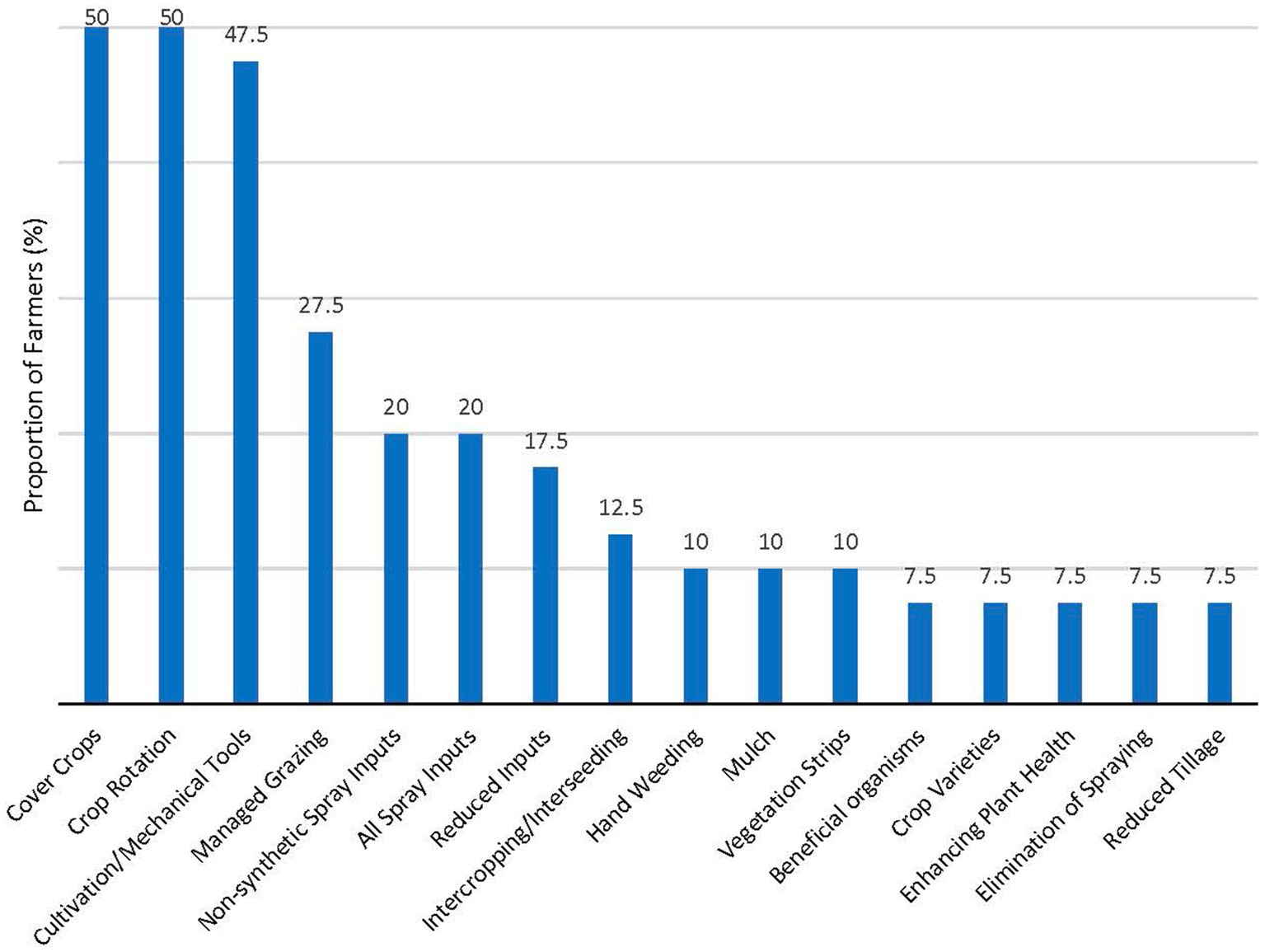
Figure 4. Farmer-identified crop protection practices (practices are only shown if mentioned by more than 5% of farmers).
Strategies that promote beneficial insects (e.g., vegetative strips) were mentioned by only 10% of respondents, despite their relatively high adoption by the farmers interviewed. Interestingly, the farmers interviewed for this study did not associate vegetation strips with pest management, despite their documented effectiveness as beneficial insect habitat (Grashof-Bokdam and Van Langevelde, 2005; Herzog et al., 2005; Schweiger et al., 2005). This lack of association with pest management could be due to the inconsistent benefits of vegetation strips on reducing pest populations at field scale after implementation of those practices for other ecosystem services, such as erosion control and water management. Further, despite increases in beneficial insect populations when prairie strips are used (Haaland et al., 2011; Middleton et al., 2021), pest insect predation and subsequent pest pressure on crops can be neutral or inconsistent (Cox et al., 2014), further contributing to lack of farmer association of this practice with pest management benefits.
3.4. Financial support for practices
The majority of the of the interviewees (75%) received financial support for the implementation of conservation practices from various state, federal, or private programs. Federal programs included those administered through the United States Department of Agriculture Natural Resource Conservation Service (USDA NRCS), such as the Conservation Reserve Program (CRP), the Environmental Quality Incentives Program (EQIP), and the Conservation Stewardship Program (CSP). EQIP and CSP are both intended to assist farmers in paying for integrating conservation practices on their farm. EQIP payments are intended for small, individual projects such as planting grass seed in waterways to prevent erosion, whereas CSP is intended to help pay for whole-farm projects, typically integrating multiple projects for broader aims such as erosion control, water quality or wildlife habitat enhancement. To a lesser extent, farmers cited support from the Farm Services Agency (FSA), crop insurance programs [e.g., Agriculture Risk (ARC) and Price Loss Coverage (PLC) programs]. Examples of state-based programs included funding focused on water quality protection (such as through the Wisconsin and Minnesota State Departments of Agriculture) while private funding included non-profit entities such as Ducks Unlimited.
Farmers who received financial assistance were more likely to integrate vegetation strips (including for the management of waterways and pollinator habitat) into their farm practices (Figure 5). The relationship between financial compensation and practice implementation may be related to the lack of association with other benefits that could provide economic benefits, such as improved pest control and subsequent ability to reduce inputs. A slightly higher occurrence of no-till practices and managed grazing was associated with financial assistance. The use of diverse crop rotations, intercropping, cultivar mixtures and biocontrol were more often associated with farmers not receiving financial incentive payments.
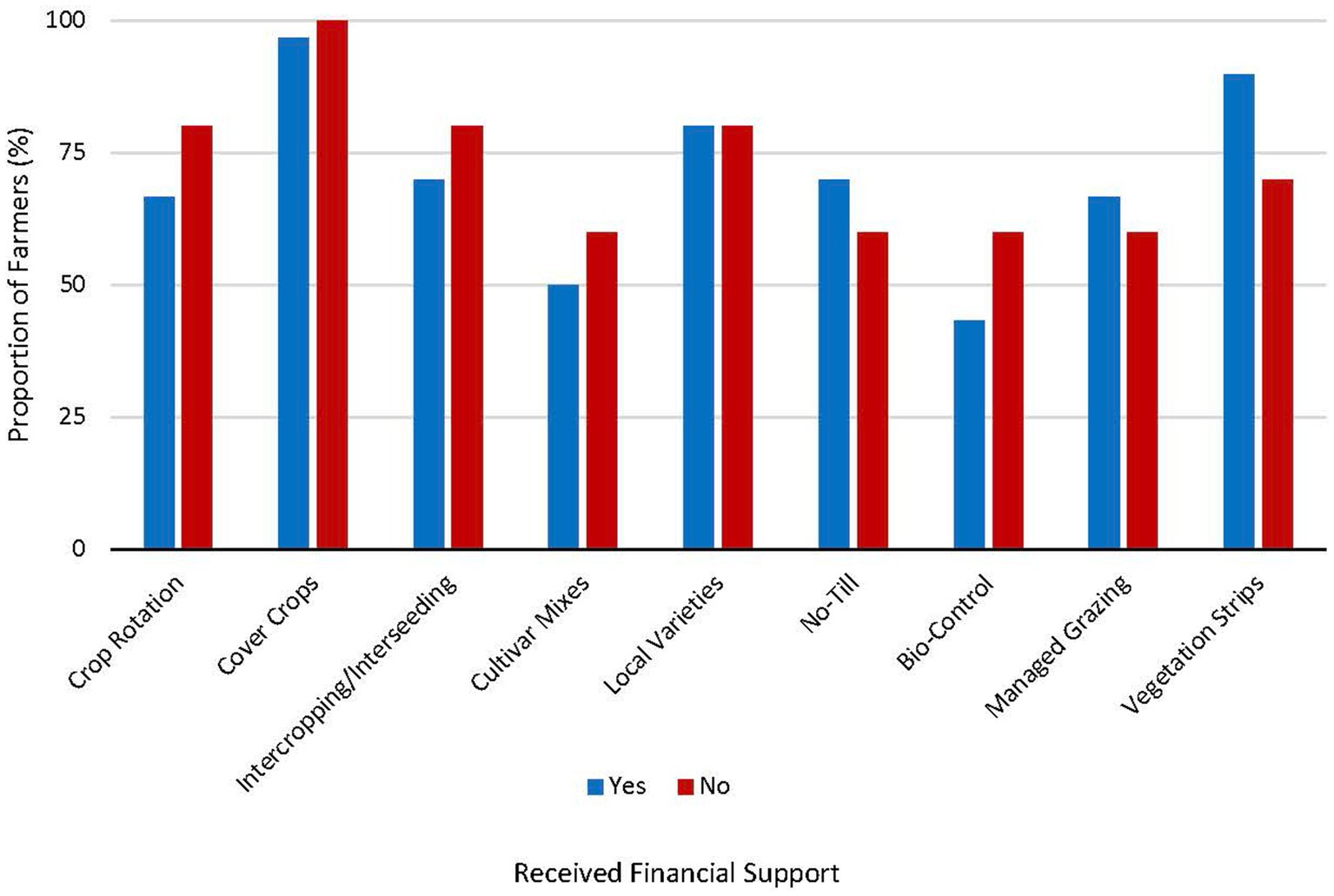
Figure 5. Adoption of agroecological conservation practices by farmers with and without financial support. Proportion of farmers (%) calculated by comparing the number of farmers adopting the conservation practice within each specific category with the total number of farmers overall in each category (with and without receiving financial support).
Previous studies have documented associations between financial assistance payments and the adoption of specific conservation practices. For example, the implementation of perennial covers associated with pasture, riparian buffers, and restored wetlands, which have been perceived by farmers as expensive conservation practices, have often required monetary incentives to make implementation feasible (Atwell et al., 2008). However, previous research has also shown that farmers adopt conservation practices for multiple reasons (e.g., normative obligations) other than financial incentives (Prager and Posthumus, 2010; Osmond et al., 2015; Meijboom and Stafleu, 2016) thus, the relative impact of financial assistance on facilitating practice adoption will likely be practice specific as well as due to intrinsic motivation and technical skills of farmers to adopt them (Atwell et al., 2008; Prager and Posthumus, 2010).
Different studies that have shown that farmers do not necessarily require cost-share or financial incentives to maintain commitment to certain agroecological practices that improve soil health and improve water quality, such as cover crops (Dunn et al., 2016; Roesch-McNally et al., 2017c). Thus, the design of incentive programs to promote and sustain adoption of agroecological practices should also consider broader farmer motivations leading to greater commitment to maintaining agroecological principles as part of systems-based management. Other policy supports, such as funding for improved aggregation and processing infrastructure as well as incentives for institutional procurement, could help support the financial viability of a more diverse crop rotation, enabling the integration of agroecological processes by expanding access to more profitable market outlets for a wider variety of crop and animal-based products.
3.5. Impact on organic certification of conservation practice adoption
Approximately half of the farmers interviewed had at least some of their land managed as certified organic under the USDA National Organic Program (NOP) (Table 1). Overall, we found no association of organic certification with the number of conservation practices implemented by farmers (value of p = 0.654). However, differences were seen in the type of practices implemented by farmers managing at least a portion of their farm as certified organic (Figure 6). Certain conservation practices (crop rotation, cultivar mixtures, local varieties, biocontrol, managed grazing, and vegetation strips) were implemented more frequently by organic certified farms as compared to conventional farms, and certain practices less frequently used on organic farms, such as no-till practices.
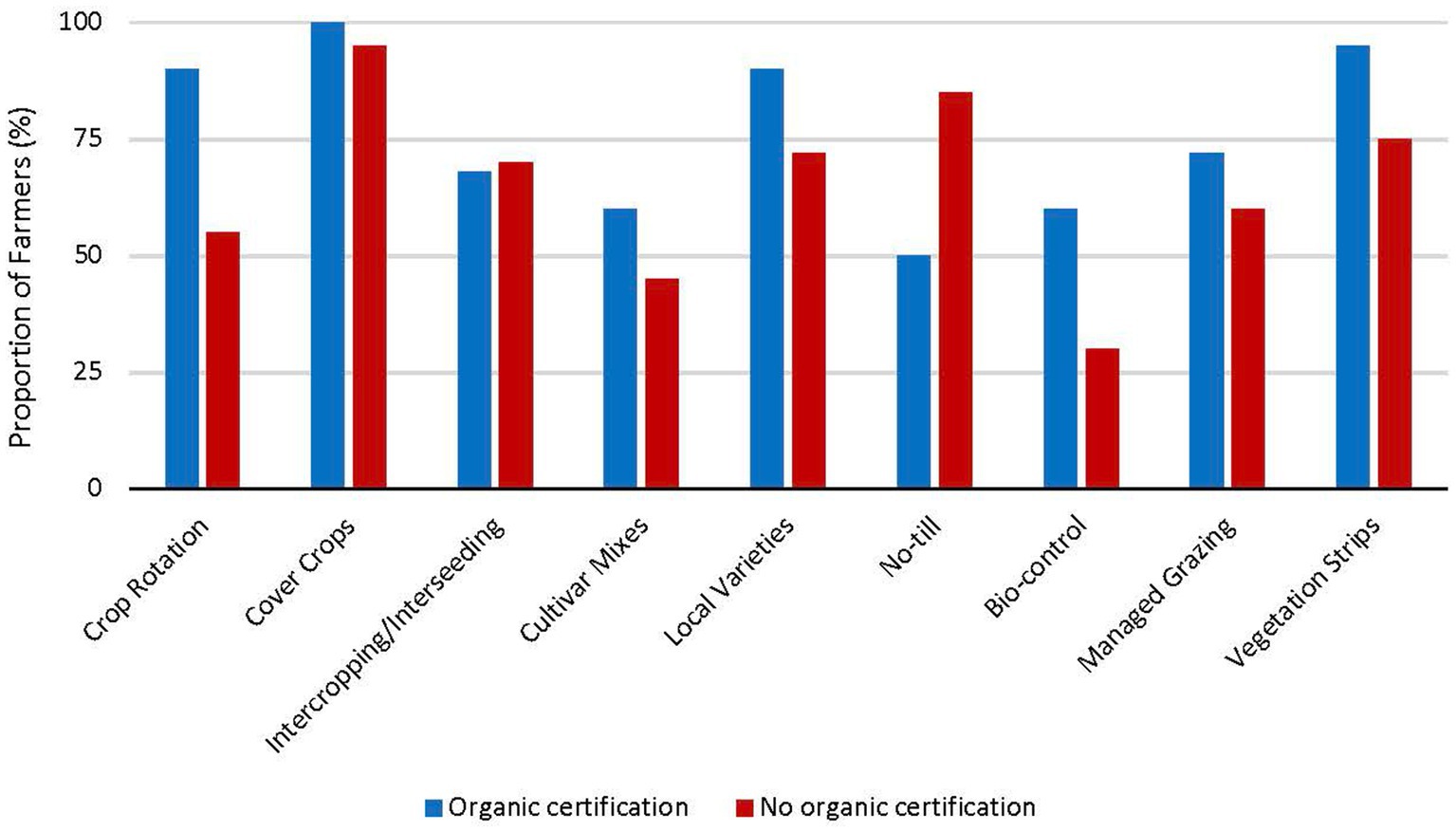
Figure 6. Adoption of agroecological conservation practices by farmers with and without organic certification. Proportion of farmers (%) calculated by comparing the number of farmers adopting the conservation practice within each specific category with the total number of farmers overall in each category (with and without organic certification).
Differences in the implementation of conservation practices by organic and conventional producers has been documented in previous studies. For example, nearly 40% of all organic field producers used cover crops in 2014, higher the number of conventional farmers using this practice in 2012 (7%) (Hellerstein et al., 2019). Similar trends can be observed with the practice of management intensive grazing, where 65% of organic livestock producers used rotational grazing, compared with 22% of conventional livestock producers in 2012. Further, 36% of organic farms were reported to use no-till or minimal till practices in 2019, compared to 24% of conventional farms identifying the use of these practices (USDA, 2017, 2019). Other studies have documented that organic farmers have greater environmental awareness and concern for the environment than their conventional counterparts, as documented in several studies from across the globe (Dubgaard and Sorensen, 1988; Fisher, 1989; Sullivan et al., 1996; McCann et al., 1997; Fairweather, 1999).
3.6. Adoption of multiple conservation practices
The farmers interviewed for this study typically integrated more than one conservation practice into their farming operation. The heatmap (Figure 7) generated from their responses shows that farmers using cover crops, the most frequently used conservation practice, more frequently also integrated the use of grass strips and local varieties. Further, farmers using cover crops also tended to more frequently use practices such as intercropping, crop rotation and no-till. Biocontrol and flower strips are the less frequently used overall as individual practices and were less frequently associated with the use of no-till practices and cultivar mixes. Interestingly, flower strips were not associated with the use of biocontrol practices, which may indicate that farmers associate the planting with strips more with pollinator habitat than biocontrol benefits.
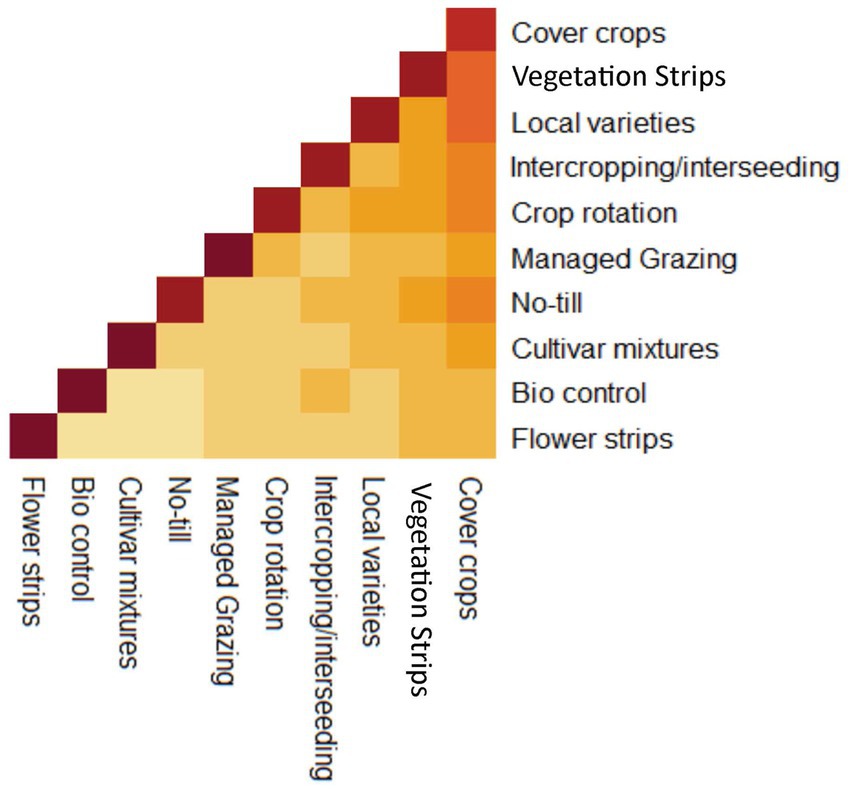
Figure 7. Heat map indicating combination of practices among farmers found (darker orange indicates higher frequency whereas light yellow low frequency).
The associated use of specific practices might be also related to the major motivations of farmers implementing conservation practices. Here, soil health is the leading motivation as shown in the following section. The practices targeting soil health and which were more often used also in association were cover crops, intercropping, crop rotation and no-till.
3.7. Motivations to implement conservation practices
Interviewees mentioned different drivers influencing the implementation of conservation practices (Figure 8). Improving soil quality was the main motivation for farmers (55%) to implement conservation practices, often with the more specific goal of improving soil biological activity. Other soil quality enhancements sought by farmers in our study included improved soil structure and improved ability to retain nutrients. Maintaining or improving water quality and water management also ranked high with respect to farmer motivations of adoption of conservation practices, with erosion, water retention and water quality appearing in 60% of the answers of interviewees.
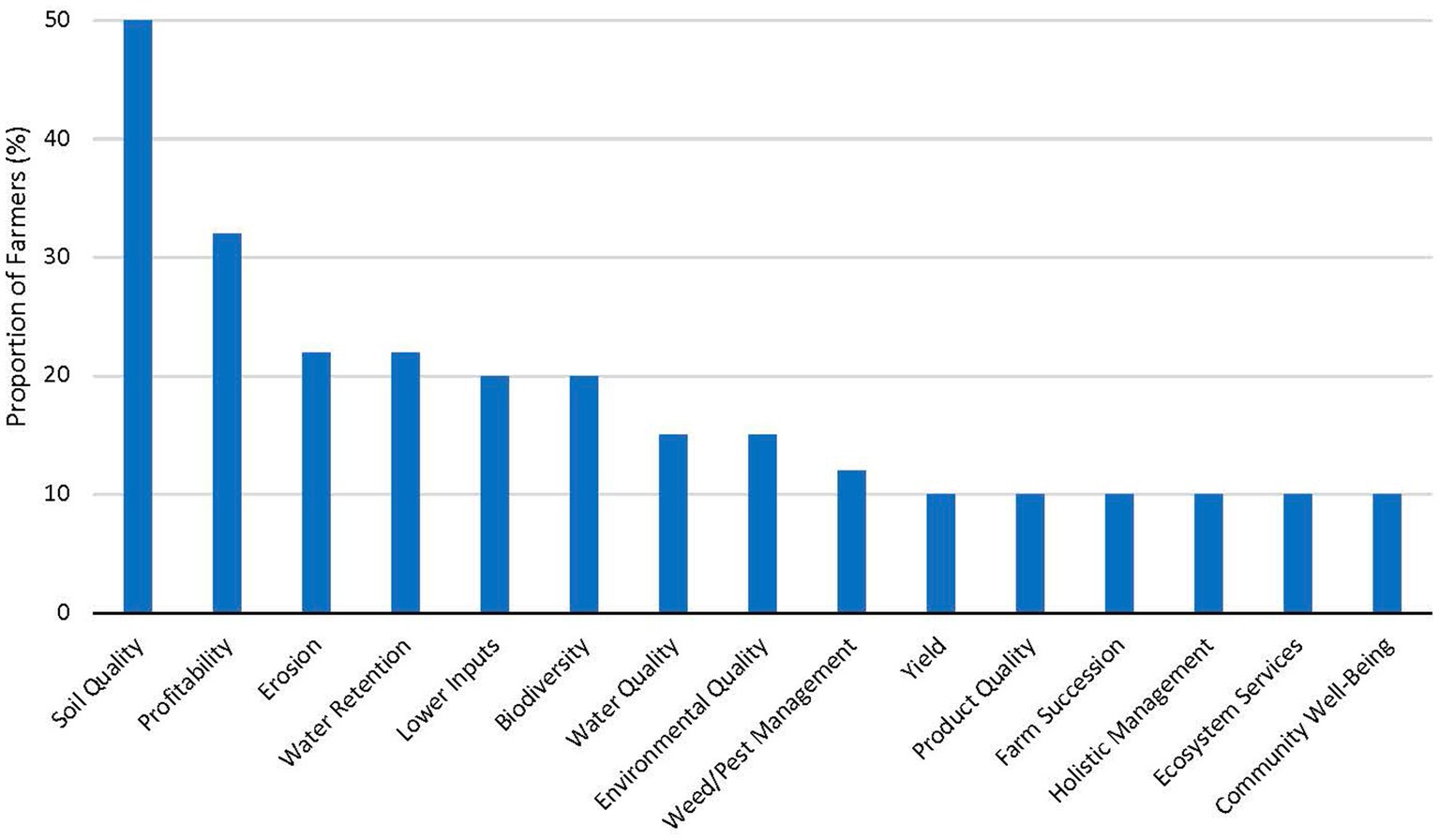
Figure 8. Main motivations for implementation of agroecological conservation farming practices (motivation themes are only shown if mentioned by at least 10% of farmers).
Other studies have similarly found that soil quality and health-related benefits were motivators for the adoption of conservation practices, including erosion reduction from cover crops, filter strips, grassed waterways, hedgerows, rotational grazing, and no-till (Brodt et al., 2009; Reimer et al., 2012; Brummel and Nelson, 2014; Reimer and Prokopy, 2014; Xie, 2014; Roesch-McNally et al., 2017a,b,c), as well as soil improvements associated with the implementation of perennials, organic practice in general, cover crops, no-till, and rotational grazing (Brummel and Nelson, 2014; Reimer and Prokopy, 2014; Adebiyi et al., 2016; Bossange et al., 2016; Ulrich-Schad et al., 2017). The types of practices implemented most frequently by the farmers in our study align with the motivation of improved soil health. Cover crops are widely viewed by technical soil and water conservation advisors to be an effective means for reducing soil erosion and nutrient loss and increasing soil health (Arbuckle and Roesch-McNally, 2015). Similarly, vegetation strips are a common practice to implement in waterways and reduce erosion. As several of the farmer groups from which our interview sample was recruited have an emphasis on water quality (e.g., Practical Farmers of Iowa and Wisconsin’s Farmer-Led Watershed groups), our interviewees likely had substantial opportunities to become familiar with research and best management practices which link conservations strategies to erosion management.
Profitability was identified as a second important motivator for the adoption of conservation practices. Within this context of a motivator, profitability can be viewed from two perspectives. First, farmers recognized the potential economic savings that could result from the implementation of conservation farming practices, including the reduced need for inputs to manage weeds, insects, and diseases, or the reduced fuel costs due to fewer field operations (e.g., with no-till management or managed grazing). Other studies have found that reduced input costs, including fuel, labor, and nutrient additions, were a motivation to practice adoption (Reimer et al., 2012; Stuart et al., 2014). The second aspect of profitability which motivated farmers was related to increased yields or market premiums that were realized when these practices were adopted.
Several studies have showed that farmers’ perceptions of the importance of soil health as a broader asset to their farm, as well as the specific economic benefits of soil health practices, both play important roles in conservation practice adoption (Singer et al., 2007; Bergtold et al., 2012; Reimer and Prokopy, 2014; Wang et al., 2019). More specifically, previous literature has documented that farmers’ emphases on improving soil health and the related soil health attributes of the new practice tend to positively influence adoption decisions, while farmers who need more monetary incentives to adopt such practices are less likely to adopt (Adesina and Baidu-Forson, 1995; Ryan et al., 2003; Singer et al., 2007; Bergtold et al., 2012; Reimer and Prokopy, 2014; Wang et al., 2019). The motivation of soil health may be related to the farmers’ assumptions that these improvements will increase yields while reducing the need for chemical inputs, which will improve their profitability in the longer term (Plastina et al., 2020). These studies, complemented by the results of our interviews, highlight the importance of not only understanding the economic scenarios related to conservation practice outcomes and supports, but also helping farmers better understand the broader value of agroecological practices to their operations, particularly those related to the improved function of their farms in the longer term.
To a lesser extent, biodiversity and mitigation of environmental stresses (e.g., water stress) were stated as main drivers by 20% and 12.5% of farmers, respectively. Similarly, social motivations related to the adoption of conservation practices were less cited, although farmers did state a desire to adopt practices that promoted their ability to be responsible stewards the land, particularly as related to maintaining and restoring the land for future generations. In a recent study of organic grain farmers in Iowa, a similar lower prioritization was placed on broader social benefits, where civic-mindedness goal orientation was rated lower than the goals of profitability and natural resource stewardship (Han et al., 2021).
Livestock grazing can also motivate the adoption of conservation practices. Farmers with livestock perceived higher levels of compatibility between their systems and cover crops (Arbuckle and Roesch-McNally, 2015). These results suggest that integrating livestock in cropping systems could further facilitate conservation practice implementation while providing additional landscape-level benefits (e.g., weed/insect suppression or extreme weather mitigation) that come with a more diversified agricultural system (Lin, 2011; Davis et al., 2012; Kremen and Miles, 2012). A significant number of farmers interviewed mentioned currently practicing grazing livestock on crop fields as well as the desire to do it in the future. Integration of livestock into grain cropping systems is of increasing interest to farmers seeking more advanced goals related to soil health on their farms, as it is a key element listed in the NRCS five soil health principles (USDA NRCS, 2022).
3.8. Barriers to implementation
Several barriers were identified to farmer adoption of conservation practices. Costs (e.g., the purchase of fencing for management intensive grazing, seed, or additional equipment) (32.5%) and the lack of knowledge (e.g., the need for specific guidance regarding best management practices for successful implementation of practices) (27.5%) were the main barriers stated by farmers (Figure 9). Beyond lack of knowledge, access to physical resources (e.g., specialized equipment; markets for more diversified crop rotation) was considered by 22.5% of the farmer as a limit to the implementation. Additionally, farmers identified financial limitations, as well as limitations with time and labor, as barriers to the implementation of conservation practice adoption.
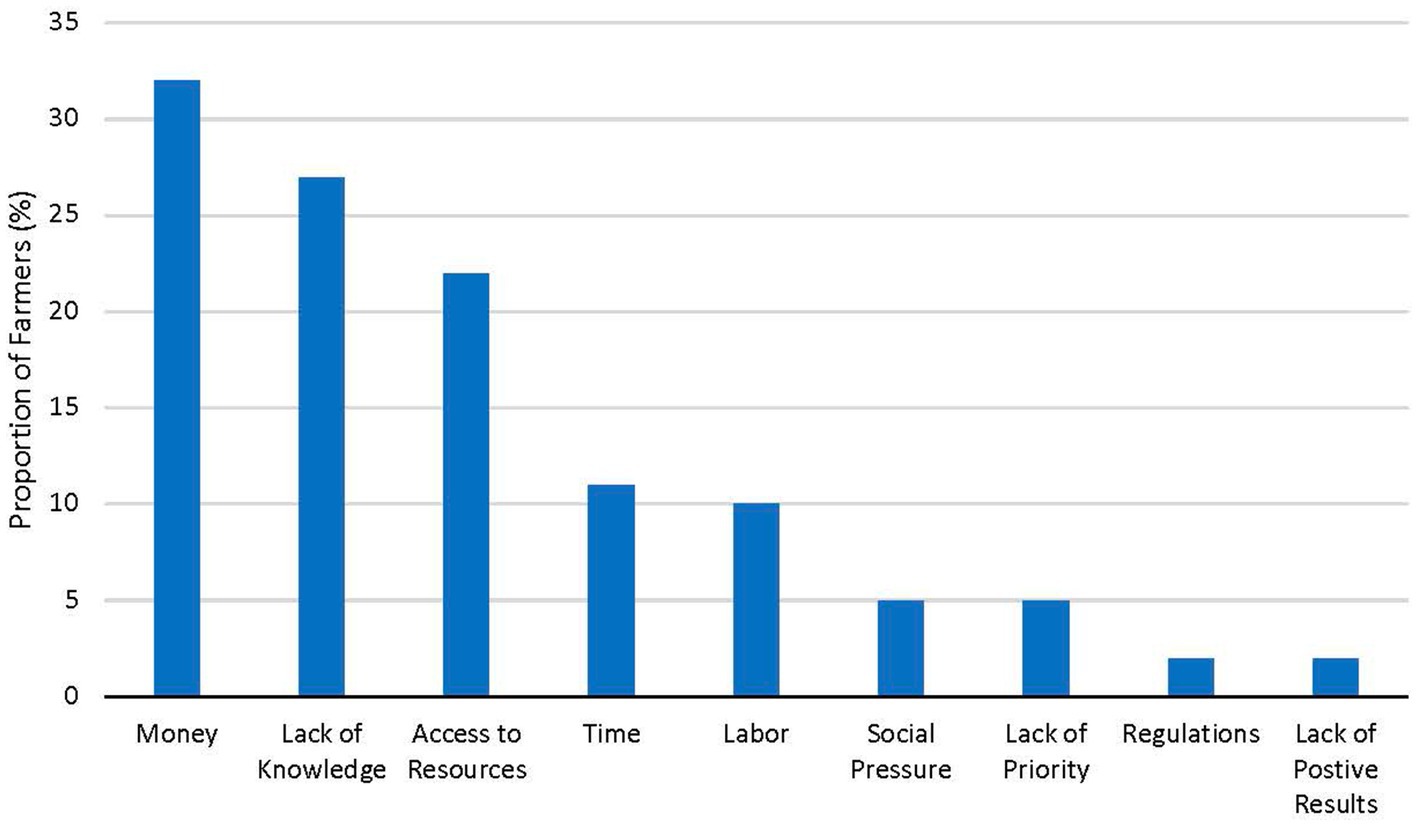
Figure 9. Barriers to implementation of agroecological conservation farming practices (barrier themes are only shown if mentioned by at least 5% of farmers).
Time and labor have been documented as barriers to conservation practice adoption (Reimer et al., 2012). Not only is the overall additional labor demand related to implementation of practices a concern, but those labor needs coming at critical times in farm management. For example, lack of timely cover crop termination and residue incorporation due to delayed operations can lead to production risks if farmers cannot manage the cover crop at an earlier growth stage appropriate for effective nutrient management and planting (Christianson et al., 2014).
Lack of knowledge, uncertainty of production outcomes, and greater perceived risk have also been cited as barriers to adoption of conservation practices. A survey related to cover crop implementation in the midwestern USA found that if technical assistance were more widely available, more farmers would attempt to use of cover crops (Arbuckle and Roesch-McNally, 2015). This same study showed that farmers who implemented cover crops were more likely to have support from conservation agencies and watershed groups, demonstrating the positive impact of access to knowledge. Adoption of other conservation practices have shown similar trends, such as the implementation of prairie strips for biodiversity (Luther et al., 2022). Further, improved infrastructure and resources to support conservation practice adoption, including the need for greater availability of seed, equipment, and expertise, remains lacking (Arbuckle and Roesch-McNally, 2015).
A further barrier is that changes in supply chains more broadly are also necessary to expand the implementation of agroecological practices, particularly in the geographic region from which our interview pool is drawn, which is dominated by the production of corn and soybean for animal feed. The narrow rotation of long-season crops limits the possibility of integrating alternative practices, such as cover crops and grazing, into the system (Peterson et al., 2019). Previous studies have documented those farmers who had more diverse operations, including the integration of livestock or additional crops, more successfully integrated cover crops into their farming operations (Stuart and Gillon, 2013). However, despite proven agroecological benefits as well as benefits to yields (Volsi et al., 2022), adoption of diverse rotations is hindered by lack of readily accessible and profitable regional markets. Alternative marketing strategies such as cooperative marketing, direct marketing, and institutional procurement programs, partnered with increased infrastructure capacity to shortened supply chains, could facilitate expanded implementation of diverse rotations and, in turn, facilitate agroecological practice adoption. The structural barriers existing beyond the farm can drive farm management decisions, limiting innovation and willingness to attempt alternative farm strategies (Bartels et al., 2013).
3.9. Planned future implementation of practices
Farmers were asked about additional conservation practices planned for the future. Almost all farmers (92.5%) were considering the implementation of at least one new practice. Increasing the use of cover crops, as well as planting more trees, were frequently mentioned practice changes, with about 20% of farmers seeking these goals (Figure 10). Expanded or new implementation of no-till practices was mentioned as by 20% of the farmers interviewed, while 17.5% planned to improve their management intensive grazing systems and add practices to improve biodiversity. This goal to increase biodiversity was often expressed as a broader goal of environmental protection, but also as a desire to support pollinators and beneficial insects.
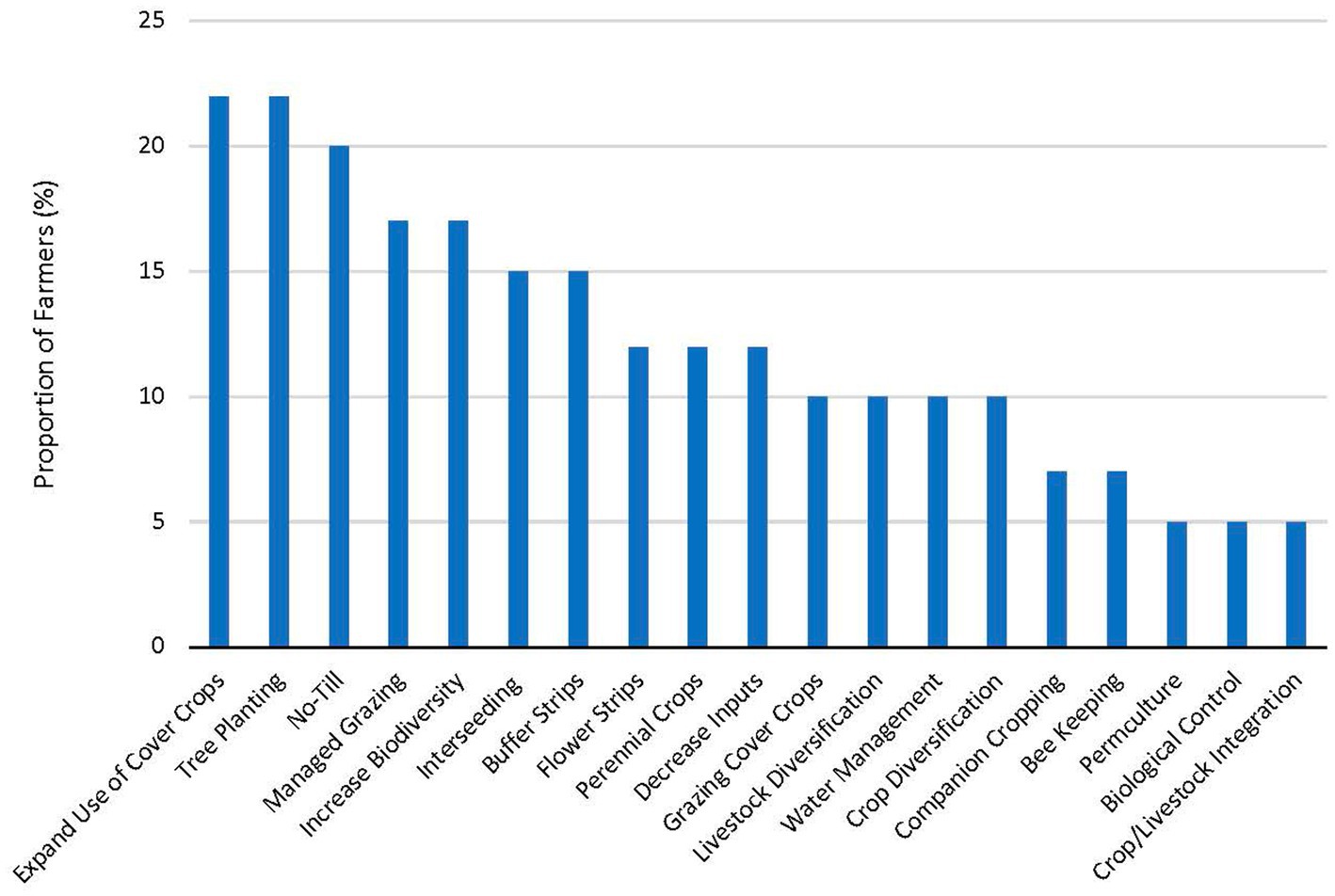
Figure 10. Future plans for implementation of agroecological conservation practices identified by farmers (practices are only shown if mentioned by at least 5% of farmers).
3.10. Study limitation
Some limitations of the study can be mentioned here. There was no representative sampling of farms per type of farming, farm size or other factor that was carried out. But the goal was an exploratory study to get first insights into the use of conservation practices of farmers, farmers’ motivations to use them and barriers for implementation. A second one is that we could only survey which practices farmers use on the farm, but not explicitly on each field or plot of their farm. For this a much larger study would be needed in investigating the use of conservation practices per field, but this was not feasible. In such a future study, field investigations would also be necessary and relating the use of practices to, e.g., soil type, crops grown, rotation, location on the farm per field. Moreover, we could see with some data analysis not presented here that there are some tendencies in the use of some practices regarding farm size. More in-depth analyses, with additional farm data, and investigating as well differences regarding farming types or for which crops the practices are used could provide further insights into the adoption of conservation practices.
4. Conclusion
This study broadens our understanding of the adoption patterns of different conservation farming practices implemented by farmers demonstrating an existing interest in their use. Our results show that many of the farmers interviewed used not just one conservation practice, but typically use multiple conservation practices. This study showed that conservation practices with the highest adoption tended to be the practices most often co-adopted. And for this soil health seems to be an important driver and motivation for farmers to adopt them. However, we also found certain practices that were less likely to be used in combination.
Our data also demonstrated that the conservation practices with high levels of adoption (e.g., cover crops) had substantial support with respect to technical assistance and financial assistance. However, our study also highlights practices that would profit from more investment in the development of successful implementation strategies, supported by providing specific additional financial incentives for them, such as the use of flowering strips and enlarged use of biocontrol. Understanding how to design complementarity between more frequent and lesser used practices (e.g., managing pastures to enhance beneficial insect habitat, using diverse cover crop mixes with flowering species) could derive additional agroecological benefits from practice implementation while mitigating risks and financial burdens to the farmer. Additionally, understanding complementarities, as well as differences in barriers and motivation, can help design more holistic financial incentive schemes to promote practices that are riskier or knowledge intensive to implement, yet may provide substantial agroecosystem benefits.
The impact of certification strategies on adoption of some practices also emerged from our study. As public and private programs, including those related to “regenerative” or “climate smart” agriculture, continue to develop, the inclusion of certain conservation practices within these certification schemes could be a positive driver with respect to further implementation.
The motivations and barriers faced by the farmers in this study, who already had made steps to implement conservation practices on their farms, were consistent with those documented in previous studies. A persistent need exists for more knowledge and resources not only the technical details related to the execution of practices, but also the short and long-term soil health benefits and economic impacts. The dual motivations of broader goals of soil health improvement and profitability must be considered in designing education and incentive programs to motivate new and sustained adoption of practices. The findings outlined in this study also highlight the role of farmer networks, particularly those with a conservation focus, in reducing barriers through creating learning communities to not only accelerate knowledge generation and sharing, but to alleviate the social barriers that inhibit farmer adoption of conservation practices.
Data availability statement
The raw data supporting the conclusions of this article will be made available by the authors, without undue reservation.
Author contributions
AW and ES: conceptualization. AW, ES, and MR: research design. CS, JB, NB, NC, CC, and MB: data collection. NB, JB, NC, CC, CS, AW, and ES: data analysis and interpretation and writing manuscript. AS, CS, JB, and ES: editing manuscript. All authors contributed to the article and approved the submitted version.
Funding
This work was supported by the University of Wisconsin-Madison Organic Collaborative and the Agroecology program at ISARA.
Acknowledgments
We are highly grateful to the farmers that were willing to share their time and knowledge with us for data collection.
Conflict of interest
The authors declare that the research was conducted in the absence of any commercial or financial relationships that could be construed as a potential conflict of interest.
Publisher’s note
All claims expressed in this article are solely those of the authors and do not necessarily represent those of their affiliated organizations, or those of the publisher, the editors and the reviewers. Any product that may be evaluated in this article, or claim that may be made by its manufacturer, is not guaranteed or endorsed by the publisher.
References
Adesina, A., and Baidu-Forson, J. (1995). Farmers’ perceptions and adoption of new agricultural technology: evidence from analysis in Burkina Faso and Guinea, West Africa. Agric. Econ. 13, 1–9. doi: 10.1016/0169-5150(95)01142-8
Adebiyi, J, Olabisi, L. S., and Snapp, S. (2016). Understanding perennial wheat adoption as a transformative technology: evidence from the literature and farmers. J. Renew. Agric. Food Syst. 31, 101–110.
Arbuckle, J. G., and Roesch-McNally, G. (2015). Cover crop adoption in Iowa: the role of perceived practice characteristics. J. Soil Water Conserv. 70, 418–429. doi: 10.2489/jswc.70.6.418
Atwell, R. C., Schulte, L. A., and Westphal, L. M. (2008). Linking resilience theory and diffusion of innovations theory to understand the potential for perennials in the U.S. Corn Belt. Ecology and society 14(1): 30. Available at: http://www.ecologyandsociety.org/vol14/iss1/art 30/
Banga, S. S., and Kang, M. S. (2014). Developing climate-resilient crops. J. Crop Improv. 28, 57–87. doi: 10.1080/15427528.2014.865410
Bartels, W. L., Furman, C. A., Diehl, D. C., Royce, F. S., Dourte, D. R., Ortiz, B. V., et al. (2013). Warming up to climate change: a participatory approach to engaging with stakeholders in the southeast US. Reg. Environ. Chang. 13, 45–S55. doi: 10.1007/s10113-012-0371-9
Bergtold, J. S., Duffy, P. A., Hite, D., and Raper, R. L. (2012). Demographic and management factors affecting the adoption and perceived yield benefit of winter cover crops in the southeast. J. Agric. Appl. Econ. 44, 99–116. doi: 10.1017/S1074070800000195
Bezner Kerr, R., Madsen, S., Stüber, M., Liebert, J., Enloe, S., Borghino, N., et al. (2021). Can agroecology improve food security and nutrition? A review. Glob. Food Sec. 29:100540. doi: 10.1016/j.gfs.2021.100540
Boeraeve, F., Dendoncker, N., Cornélis, J. -T., Degrune, F., and Dufrene, M. (2020). Contributution of agroecological farming systems to the delivery of ecosystems services. J. Environ. Manage. 260:109576. doi: 10.1016/j.jenvman.2019.109576
Bossange, A. V., Knudson, K. M., Shrestha, A., Harben, R., and Mitchell, J. P. (2016). The potential for conservation tillage adoption in the San Joaquin Valley, California: a qualitative study of farmer perspectives and opportunities for extension. PLoS ONE 11:e0167612. doi: 10.1371/journal.pone.0167612
Brodt, S., Klonsky, K., Jackson, L., Stephen, B., and Sean Smukle, Brush. (2009). Factors affecting adoption of hedgerows and other biodiversity-enhancing features on farms in California, USA. Agroforest Syst. 76, 195–206. doi: 10.1007/s10457-008-9168-8
Brummel, R. F., and Nelson, K. C. (2014). Does multifunctionality matter to US farmers? Farmer motivations and conceptions of multifunctionality in dairy systems. J. Environ. Manage. 146, 451–462. doi: 10.1016/j.jenvman.2014.07.034
Canales, E., Bergtold, J. S., and Williams, J. R. (2020). Conservation practice complementarity and timing of on-farm adoption. Agric. Econ. 51, 777–792. doi: 10.1111/agec.12591
Christianson, R., Christianson, L., Wong, C., Helmers, M., McIssac, G., and Mulla, D. (2018). Beyond the nutrient strategies: common ground to accelerate agricultural water quality improvement in the upper Midwest. J. Environ. Manag. 206, 1072–1080. doi: 10.1016/j.jenvman.2017.11.051
Christianson, L., Knoot, T., Larsen, D., Tyndall, J., and Helmers, M. (2014). Adoption of potential nitrate mitigation practices: an ecosystem approach. Int. J. Agric. Sustain. 12, 407–424. doi: 10.1080/14735903.2013.835604
Cox, R., O’Neal, M., Hessel, R., Schulte, L. A., and Helmers, M. (2014). The impact of prairie strips on Aphidophagous predator abundance and soybean aphid predation in agricultural catchments. Environ. Entomol. 43, 1185–1197. doi: 10.1603/EN13129
Davis, T. S., Boundy-Mills, K., and Landolt, P. J. (2012). Volatile emissions from an epiphytic fungus are semiochemicals for eusocial wasps. Microb. Ecol. 64, 1059–1064. doi: 10.1007/s00248-012-0074-2
Debray, V., Wezel, A., Lambert-Derkimba, A., Roesch, K., Leiblin, G., and Francis, C. A. (2019). Agroecological practices for climate change adaptation in semiarid and subhumid Africa. Agroecol. Sustain. Food Syst. 43, 429–456.
Dubgaard, A., and Sorensen, S. N. (1988). Organic and bio-dynamic farming in Denmark: a statistical survey. Rapport, Statens-Jordbrugsokonomiske Institut, Denmark, 43, 33 pp.
Dunn, M., Ulrich-Schad, J. D., Prokopy, L. S., Myers, R. L., Watts, C. R., and Scanlon, K. (2016). Perceptions and use of cover crops among early adopters: findings from a national survey. J. Soils Water Conserv. 71, 29–40. doi: 10.2489/jswc.71.1.29
Fairweather, J. R. (1999). Understanding how farmers choose between organic and conventional production: results from New Zealand and policy implications. Agric. Hum. Values. 16, 51–63. doi: 10.1023/A:1007522819471
Findlater, K. M., Kandlikar, M., and Satterfield, T. (2019). Misunderstanding conservation agriculture: challenges in promoting, monitoring and evaluating sustainable farming. Environ. Sci. Policy 100, 47–54. doi: 10.1016/j.envsci.2019.05.027
Fisher, P. (1989). Barriers to the adoption of organic farming in Canterbury Centre for Resource Management, Lincoln College.
Foltz, J., and Lang, G. (2005). The adoption and impact of management intensive rotational grazing (MIRG) on Connecticut dairy farms. Renew. Agric. Food Syst. 20, 261–266. doi: 10.1079/RAF2005127
Gong, S., Bergtold, J. S., and Yeager, E. (2021). Assessing the joint adoption and complementarity between in-field conservation practices of Kansas farmers. Agri. Food Econ. 9, 1–24. doi: 10.1186/s40100-021-00201-8
Grashof-Bokdam, C. J., and Van Langevelde, F. (2005). Green veining: landscape determinants of biodiversity in European agricultural landscapes. Landsc. Ecol. 20, 417–439. doi: 10.1007/s10980-004-5646-1
Haaland, C., Naisbit, R. E., and Bersier, L. F. (2011). Sown wildflower strips for insect conservation: a review. Insect Conserv. Diver. 4, 60–80. doi: 10.1111/j.1752-4598.2010.00098.x
Han, G., Arbuckle, J. G., and Grudens-Schuck, N. (2021). Motivations, goals, and benefits associated with organic grain farming by producers in Iowa, US. Agric. Syst. 191:103175. doi: 10.1016/j.agsy.2021.103175
Hatt, S., Boeraeve, F., Artru, S., Dufrene, M., and Francis, F. (2018). Spatial diversification of agroecosystems to enhance biological control and other regulating services: an agroecological perspective. Sci. Total Environ. 621, 600–611. doi: 10.1016/j.scitotenv.2017.11.296
Hellerstein, D., Viorio, D., Ribaudo, M., Aillery, M., Bigelow, D., Bowman, M., et al. (2019). Agricultural resources and environmental indicators, 2019. Econ. Inform. Bull. EIB-208:142.
Herzog, F., Dreier, S., Hofer, G., Marfurt, C., Schupbach, B., Spiess, M., et al. (2005). Effect of ecological compensation areas on floristic and breeding bird diversity in Swiss agricultural landscapes. Agric. Ecosyst. Environ. 108, 189–204. doi: 10.1016/j.agee.2005.02.003
Jat, R. A., Sahrawat, K., Kassam, A., and Friedrich, T. (2014). Conservation agriculture for sustainable and resilient agriculture: global status, prospects and challenges. Editors: R.A. Jat, K.L. Sahrawat, and A.H. Kassam Wallingford, Oxfordshire, UK: CABI International.
Krause, M. A. (2017). Optimal adoption strategies for no-till technology. Am. J. Agric. Econ. 75:1296.
Kremen, C., and Miles, A. (2012). Ecosystem services in biologically diversified versus conventional farming systems: benefits, externalities, and trade-offs. Ecol. Soc. 17:40.
Kuhn, K. (2018). Benefits of conservation planning to farmers, landowners, and society. Webinar, Ames, IA: Iowa. Available at: https://vimeo.com/user42671352/review/290760563/4af;a07b69.
Lee, S., and McCann, L. (2019). Adoption of cover crops by US soybean producers. J. Agric. Appl. Econ. 52, 527–544.
Liebert, J., Benner, R., Bezner Kerr, R., Björkman, T., Teigen De Master, K., Gennet, S., et al. (2022). Farm size affects the use of agroecological practices on organic farms in the United States. Nat. Plants 8, 897–905. doi: 10.1038/s41477-022-01191-1
Lin, B. B. (2011). Resilience in agriculture through crop diversification: adaptive management for environmental change. Bio Sci. 61, 183–193.
Luther, Z. R., Swinton, S. M., and Van Deynze, B. (2022). Potential supply of Midwest cropland for conversion to in-field prairie strips. Land Econ. 98, 274–291. doi: 10.3368/le.98.2.082020-0129R1
McCann, E., Sullivan, S., Erickson, D., and DeYoung, R. (1997). Environmental awareness, economic orientation, and farming practices: a comparison of organic and conventional farmers. Environ. Manag. 21, 747–758. doi: 10.1007/s002679900064
Meijboom, F. L. B., and Stafleu, F. R. (2016). Farming ethics in practice: from freedom to professional moral autonomy for farmers. Agric. Hum. Values. 33, 403–414.
Middleton, E. G., Mac Rae, I. V., and Philips, C. R. (2021). Floral plantings in large-scale commercial agroecosystems support both pollinators and arthropod predators. Insects 12:91. doi: 10.3390/insects12020091
Moore, V. M., Mitchell, P. D., Silva, E. M., and Barham, B. L. (2016). Cover crop adoption and intensity on Wisconsin's organic vegetable farms. Agroecol. Sustain. Food Syst. 40, 693–713. doi: 10.1080/21683565.2016.1181694
Osmond, D. L., Hoag, D. L., Luloff, A. E., Meals, D. W., and Neas, K. (2015). Farmers’ use of nutrient management: lessons from watershed case studies. J. Environ. Qual. 44, 382–390. doi: 10.2134/jeq2014.02.0091
Paracchini, M., Justes, E., Wezel, A., Zingari, P. C., Kahane, R., Madsen, S., et al. (2020). Agroecological practices supporting food production and reducing food insecurity in developing countries, Publications Office of the European Union, Luxembourg
Peterson, A. T., Berti, M. T., and Samarappuli, D. (2019). Intersowing cover crops into standing Soybean in the US upper midwest. Agronomy. 9:264. doi: 10.3390/agronomy9050264
Plastina, A., Liu, F., Miguez, F., and Carlson, S. (2020). Cover crops use in Midwestern US agriculture: perceived benefits and net returns. Renew Agric Food Syst. 35, 38–48. doi: 10.1017/S1742170518000194
Prager, K., and Posthumus, H. (2010). “Socio-economic factors influencing farmers’ adoption of soil conservation practices in Europe” in Human dimensions soil and water conservation. ed. T. L. Napier (United Kingdom: Nova Science Publications), 1, 388–321.
Reimer, A. P., and Prokopy, L. S. (2014). Farmer participation in US farm bill conservation programs. Environ. Manag. 53, 318–332. doi: 10.1007/s00267-013-0184-8
Reimer, A., Thompson, A., and Prokopy, L. (2012). The multi-dimensional nature of environmental attitudes among farmers in Indiana: implications for conservation adoption. Agric. Hum. Values 29, 29–40. doi: 10.1007/s10460-011-9308-z
Roesch-McNally, G. E., Arbuckle, J. G., and Tyndall, J. C. (2017a). What would farmers do? Adaptation intentions under a corn belt climate change scenario. Agric. Hum. Values 34, 333–346. doi: 10.1007/s10460-016-9719-y
Roesch-McNally, G. E., Arbuckle, J. G., and Tyndall, J. C. (2017b). Soil as social-ecological feedback: examining the ethic of soil stewardship among Corn Belt farmers. Rural. Sociol. 83, 145–173. doi: 10.1111/ruso.12167
Roesch-McNally, G. E., Basch, A., Arbuckle, J. G., Tyndall, J. C., Miguez, F., Bowman, T., et al. (2017c). The trouble with cover crops: Farmers' experiences with overcoming barriers to adoption. Renew. Agric. Food Syst. 33, 322–333. doi: 10.1017/S1742170517000096
Ryan, R. L., Erickson, D. L., and De Young, R. (2003). Farmers’ motivations for adopting conservation practices along riparian zones in a mid-western agricultural watershed. J. Environ. Plan. Manag. 46, 19–37. doi: 10.1080/713676702
Sawadgo, W., and Pastina, A. (2022). The invisible elephant: disadoption of conservation practices in the United States. Choices. Quarter 1. Available at: https://www.choicesmagazine.org/choices-magazine/submitted-articles/the-invisible-elephant-disadoption-of-conservation-practices-in-the-united-states
Schweiger, O., Maelfait, J. P., Van Wingerden, W., Hendricks, F., Billeter, R., Speelmans, M., et al. (2005). “Quantifying the impact of environmental factors on arthropod communities in agricultural landscapes across organizational levels and spatial scales” in Landscape ecology for sustainable environment and culture, chapter 14. eds. F. Bojie and B. Jones (Dordrecht Heidelberg, NY, London: Springer Publishing).
Singer, J. W., Nusser, S. M., and Alf, C. J. (2007). Are cover crops being used in the US corn belt? J. Soil Water Conserv. 62, 353–358.
Stuart, D., and Gillon, S. (2013). Scaling up to address new challenges to conservation on US farmland. Land Use Policy 31, 223–236. doi: 10.1016/j.landusepol.2012.07.003
Stuart, D., Schewe, R. L., and McDermott, M. (2014). Reducing nitrogen fertilizer application as a climate change mitigation strategy: understanding farmer decision-making and potential barriers to change in the US. Land Use Policy 36, 210–218. doi: 10.1016/j.landusepol.2013.08.011
Sullivan, S., McCann, E., de Young, R., and Erickson, D. (1996). Farmers’ attitudes about farming and the environment: a survey of conventional and organic farmers. J. Agric. Environ. Ethics 9, 123–143. doi: 10.1007/BF03055298
Ulrich-Schad, J. D., Brock, C., and Prokopy, L. S. (2017). A comparison of awareness, attitudes, and usage of water quality conservation practices between Amish and non-Amish farmers. Soc. Nat. Resour. 30, 1476–1490. doi: 10.1080/08941920.2017.1364457
USDA. (2017). Census of agriculture. Available at: https://www.nass.usda.gov/Publications/AgCensus/2017/Full_Report/Volume_1,_Chapter_1_US
USDA. (2019). 2019 organic survey. Available at: https://www.nass.usda.gov/Publications/AgCensus/2017/Online_Resources/Organics/ORGANICS.pdf
USDA NRCS. (2013). National and state resource concerns and planning criteria. Washington, DC: USDA NRCS.
USDA NRCS. (2022). Soil health. Available at: https://www.nrcs.usda.gov/wps/portal/nrcs/main/nd/soils/health/
Volsi, B., Higashi, G. E., Bordin, I., and Santos Telles, T. (2022). The diversification of species in crop rotation increases the profitability of grain production systems. Sicentific Rep. 12:19849. doi: 10.1038/s41598-022-23718-4
Wade, T., Claassen, R., and Wallander, S. (2015). Conservation-practice adoption rates vary widely by crop and region. USDA Economic Research Service Economic Information Bulletin Number 147. Available at: https://www.ers.usda.gov/webdocs/publications/44027/56332_eib147.pdf
Wade, T., and Classen, R. (2017). Modeling no-till adoption by corn and soybean producers: insights into sustained adoption. J. Agric. Appl. Econ. 49, 186–210. doi: 10.1017/aae.2016.48
Wang, T., Jim, H., Kasu, B. B., Jacquet, J., and Kumar, S. (2019). Soil conservation practice adoption in the northern Great Plains: economic versus Ssewardship motivations. J. Agric. Resour. Econ. 44, 404–421. Publisher: Unknown. doi: 10.22004/ag.econ.287989
Wang, T., Jin, H. L., Kreuter, U., Feng, H. L., Hennsesy, D. A., Teague, R., et al. (2020). Challenges for rotational grazing practice: views from non-adopters across the Great Plains, USA. J. Environ. Manag. 256:109941. doi: 10.1016/j.jenvman.2019.109941
Wezel, A., Casagrande, M., Celette, F., Vian, J. F., Ferrer, A., and Peigné, J. (2014). Agroecological practices for sustainable agriculture. A review. Agron. Sustain. Dev. 34, 1–20. doi: 10.1007/s13593-013-0180-7
Wezel, A., and Silva, E. (2017). “Agroecology and agroecological cropping practices” in Agroecological practices for sustainable agriculture: Principles, applications, and making the transition. ed. A. Wezel (New Jersey, USA: World Scientific), 19–51.
Winsten, J. R., Richardson, A., Kerchner, C. D., Lichau, A., and Hyman, J. M. (2020). Barriers to the adoption of management-intensive grazing among dairy farmers in the northeastern United States. Renew. Agri. Food Syst. 26, 104–113.
Xie, Y. (2014). Watershed modeling, farm tenancy and adoption of conservation measures to facilitate water quality trading in the upper Scioto watershed, Ohio. Columbus, OH: The Ohio State University.
Keywords: sustainable agriculture, cover crops, agroecology, farmer practice adoption, conservation measures, soil quality, intercropping, no-till
Citation: Silva EM, Wezel A, Stafford C, Brives J, Bosseler N, Cecchinato N, Cossement C, Ranaldo M and Broome M (2023) Insights into agroecological farming practice implementation by conservation-minded farmers in North America. Front. Sustain. Food Syst. 7:1090690. doi: 10.3389/fsufs.2023.1090690
Edited by:
Aida Turrini, Independent researcher, Scansano, ItalyReviewed by:
Mauricio Gonzalez-Chang, Austral University of Chile, ChileAnne Lauvie, INRAE Occitanie Montpellier, France
Copyright © 2023 Silva, Wezel, Stafford, Brives, Bosseler, Cecchinato, Cossement, Ranaldo and Broome. This is an open-access article distributed under the terms of the Creative Commons Attribution License (CC BY). The use, distribution or reproduction in other forums is permitted, provided the original author(s) and the copyright owner(s) are credited and that the original publication in this journal is cited, in accordance with accepted academic practice. No use, distribution or reproduction is permitted which does not comply with these terms.
*Correspondence: Erin M. Silva, ZW1zaWx2YUB3aXNjLmVkdQ==
†These authors share first authorship
 Erin M. Silva
Erin M. Silva Alexander Wezel
Alexander Wezel Caley Stafford
Caley Stafford Jeanne Brives2
Jeanne Brives2 Nathan Bosseler
Nathan Bosseler Megan Broome
Megan Broome